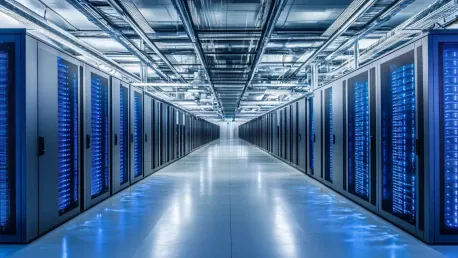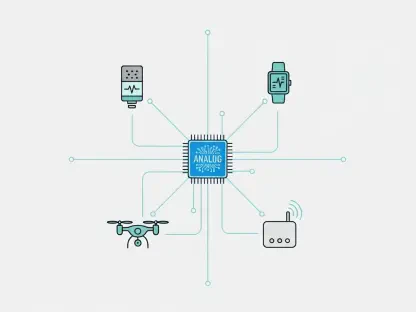Artificial Intelligence (AI) is transforming the technological landscape at an unprecedented pace, demanding massive computational resources. Recognizing this need, major tech companies and investment firms are pouring billions of dollars into building state-of-the-art data centers. These facilities are becoming pillars of the modern digital economy, driving advancements in AI and other cutting-edge technologies. This article aims to explore the motivations behind these investments, the various types of data centers, and the complex challenges involved in building and maintaining them.
The Power Behind the Digital Economy
Data centers have evolved into the backbone of the digital age, supporting everything from cloud computing to eCommerce. As AI applications grow, the demand for highly efficient and powerful data centers has skyrocketed. Hyperscale giants like Microsoft, Amazon, and Google are leading the charge by dedicating substantial capital and resources to expanding their data center capabilities. This surge in investments isn’t just about supporting existing technologies; it’s about future-proofing operations and staying competitive in a rapidly evolving market.
At the heart of this investment frenzy is the recognition that data centers are indispensable for the continued growth of AI. AI applications, especially those involving machine learning and big data analytics, require enormous computational power and data storage. The success of these applications hinges on high-performance data centers, making them a critical asset for any tech company aiming to lead in AI innovation. Furthermore, the seamless functioning of cloud-based services and eCommerce platforms hinges on the efficiency of these data centers, underscoring their multifaceted importance in the digital realm.
Diverse Data Center Types
Different types of data centers serve varied needs, each tailored to specific operational requirements. Enterprise data centers, for instance, are privately owned facilities dedicated to a single organization. These data centers offer high levels of security and reliability, ensuring that crucial business operations run smoothly. Companies with extensive data processing needs often opt for these to maintain direct control over their infrastructure.
Colocation centers, on the other hand, are multi-tenant facilities that provide flexibility for businesses to scale their operations without the hefty investment of building their own data centers. These facilities offer shared space, power, cooling, and security, making them an attractive option for companies looking to expand or optimize their data capabilities. The collaborative nature of colocation centers also enables businesses to benefit from economies of scale, driving cost efficiency alongside operational growth.
Another significant player in the data center landscape is the cloud data center. Managed by third-party providers like Amazon Web Services (AWS) and Google Cloud, these centers offer on-demand computing resources that allow companies to quickly scale up or down based on their immediate needs. This flexibility is particularly valuable for businesses with fluctuating workloads, ensuring they only pay for the resources they use. The subscription-based model also enables smaller enterprises to access top-notch infrastructure without significant upfront investment, democratizing technological advancements.
The Rise of Edge and AI Data Centers
The increasing application of real-time data processing and AI has given rise to specialized data centers designed to meet these unique demands. Edge data centers are strategically located closer to end-users to reduce latency, making them crucial for applications requiring immediate data processing and rapid response times. These facilities are vital for the deployment of technologies like autonomous vehicles, smart cities, and the Internet of Things (IoT). The proximity of edge data centers to end-users ensures minimal lag, which is essential for services that depend on real-time data inputs and outputs.
AI-specific data centers represent another specialized category. These centers are engineered to handle the intensive computational requirements of AI applications. Equipped with advanced processors and high-speed networking capabilities, AI data centers provide the necessary infrastructure to support machine learning models, big data analytics, and other AI-driven innovations. These facilities ensure that AI applications run efficiently and effectively, driving further advancements in the field. By bolstering AI infrastructure, these specialized data centers are pivotal in maintaining the momentum of AI research and application development.
Economic and Security Considerations
The strategic importance of data centers extends beyond their technological capabilities; they are also vital for economic stability and national security. The U.S. government, recognizing this, has established a Task Force on AI Datacenter Infrastructure. This task force aims to ensure that the country remains at the forefront of AI development and can protect its data infrastructure from potential threats. By focusing on the robustness and resilience of data center infrastructure, the task force aims to safeguard the nation’s technological and economic interests.
Public-private collaboration is emerging as a critical component in developing and maintaining robust data centers. By working together, tech companies and government entities can address the complex challenges of building and securing these facilities. This collaboration is crucial for preserving U.S. competitiveness in the global AI race and safeguarding the nation’s economic interests. Such partnerships enable the pooling of expertise and resources, thereby driving innovation and ensuring that data centers remain robust against evolving threats.
Navigating the Risks and Challenges
Investing in data centers comes with its own set of substantial risks. The financial outlay is enormous, and the returns on these investments are closely scrutinized by tech investors. One significant challenge is the non-fungibility of data centers. Unlike other assets, data centers are not easily repurposed for different uses. Therefore, precise planning and alignment with specific business objectives are essential to avoid costly missteps. Businesses must conduct thorough market analyses and future projections to ensure that their investments align with long-term technological trends and demands.
Another challenge is managing the operational complexities of data centers. These facilities require extensive planning, high capital expenditure, and sophisticated control systems to optimize performance and energy efficiency. The design and operation of a data center must be meticulously tailored to its intended application to ensure long-term viability. Companies must also consider the environmental impact of their data centers, implementing sustainable practices to minimize their carbon footprint. Balancing operational efficiency with environmental responsibility is crucial for the sustainable growth of data center infrastructure.
Public and Private Synergy
Artificial Intelligence (AI) is revolutionizing the technological world at a breakneck speed, requiring immense computational power. To meet this demand, leading tech firms and investment companies are investing billions of dollars in constructing cutting-edge data centers. These data centers have become foundational to the modern digital economy, propelling advancements not just in AI but in an array of advanced technologies.
This article delves into the underlying motivations for these enormous investments. It also categorizes the various types of data centers in operation and tackles the intricate challenges involved in their construction and maintenance. Data centers are essential for processing and storing the vast amounts of data necessary for AI development. Building such infrastructure involves overcoming numerous obstacles, including managing energy consumption, ensuring cybersecurity, and maintaining operational efficiency.
Additionally, as the technological landscape continues to grow, so does the complexity of maintaining these facilities. Issues like cooling systems, environmental impact, and the need for constant upgrades add layers of difficulty. Despite these challenges, the drive to support AI and other emerging technologies ensures that investment in state-of-the-art data centers will continue to soar, solidifying their role as cornerstones of our digital future.









